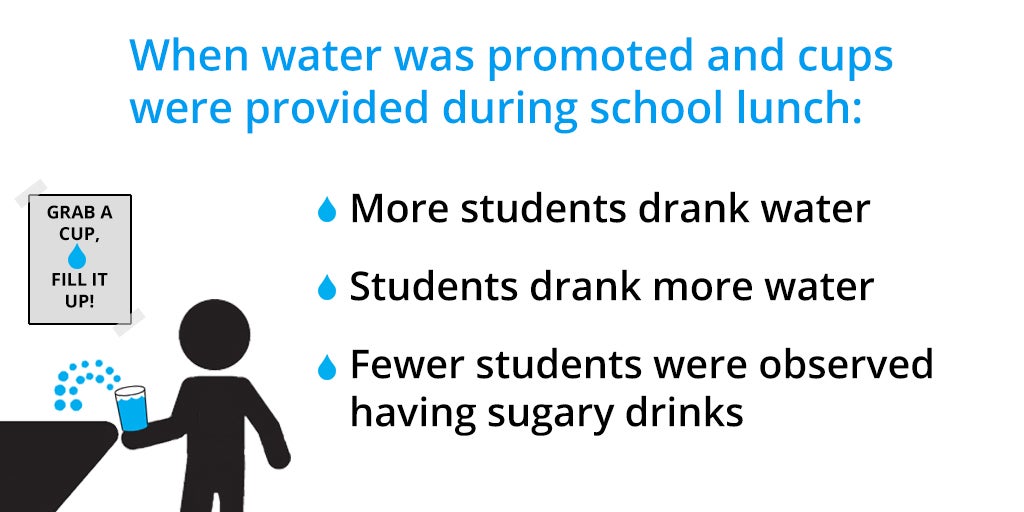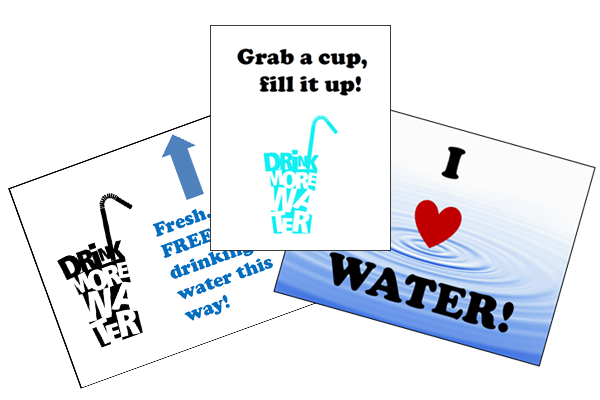A study by HPRC and Boston Public Schools found that a low-cost intervention to promote the convenience of drinking water in schools nearly doubled the percentage of students drinking water, and increased the amount of water consumed.

The Healthy, Hunger-Free Kids Act of 2010 required that schools participating the National School Lunch Program provide water to students during lunchtime. In many school cafeterias, water fountains are the current default for providing drinking water to students—though the presence of these fountains doesn’t necessarily translate to easy access or convenience, and students may not find the water appealing. The study evaluated the impact of the Boston Public Schools’ “Grab a Cup, Fill It Up” campaign, a cafeteria-based intervention featuring signage promoting water and installation of disposable cups near water fountains. The percentage of students drinking water more than doubled in intervention schools, and students drank significantly more water and had fewer sugary drinks with their lunch as a result of the intervention.
“
Promoting water in a positive light may have helped entice students to drink, but it also seems that simply making it easier for kids to drink played a big role,” said lead author Erica Kenney, a postdoctoral research fellow at the Harvard T.H. Chan School of Public Health. “We found that most students were not drinking water during lunch, and that it’s really not that easy to get a lot to drink from a fountain – we estimated that when most students drink straight from the fountain, they typically only consume about two ounces – the same amount in a little condiment cup. But when schools made it easier for students to drink by providing a five ounce cup, more students opted to drink – and they drank more water than they would have without the cups. If we want to help children drink more water, we need to do more than just depend on fountains, and cups are a simple and relatively inexpensive place to start.”
Researchers analyzed average consumption per lunch period, observing 179 lunches with 1,599 instances of students drinking water in 10 BPS schools over 47 days at baseline; and 180 lunches with 2,021 instances of students drinking water in 10 schools over 48 days at follow-up. In addition to increasing water intake in the student body, the study found that as more students consumed water during lunch, fewer were observed drinking sugar-sweetened beverages or 100% juice.
 Along with the instillation of cup dispensers and recyclable cups, simple posters encouraging students to drink water and directing students to a water source location were displayed in cafeterias. The cost of this intervention averaged less than once cent per student, per day.
Along with the instillation of cup dispensers and recyclable cups, simple posters encouraging students to drink water and directing students to a water source location were displayed in cafeterias. The cost of this intervention averaged less than once cent per student, per day.
When over half of all US children and adolescents are not adequately hydrated at any given time, this study shows that a relatively simple, inexpensive strategy to improve drinking water’s convenience and appeal can increase student water consumption.
Check out these resources to increase water access for children in your school or program:
- Download the “Grab a Cup, Fill it Up!” poster pack
- Keep it Flowing: A Practical Guide to School Drinking Water Planning, Maintenance & Repair
- Water promotion tips and tools from the Out of School Time Nutrition and Physical Activity Initiative (OSNAP)
- More water promotion resources from HPRC
- Increasing Access to Drinking Water in Schools (CDC)
- WATER WORKS: A Guide to Improving Water Access and Consumption in Schools to Improve Health and Support Learning
Kenney EL, Gortmaker SL, Carter JE, Howe CW, Reiner JF, Cradock AL. Grab a Cup, Fill It Up! An Intervention to Promote the Convenience of Drinking Water and Increase Student Water Consumption During School Lunch. American Journal of Public Health. 2015. e-View Ahead of Print.